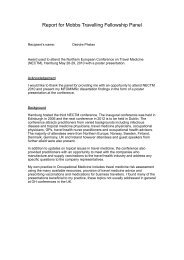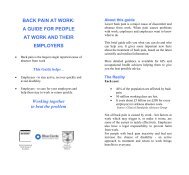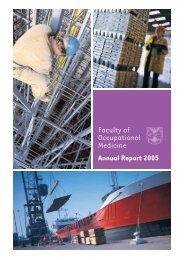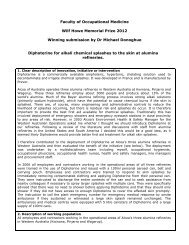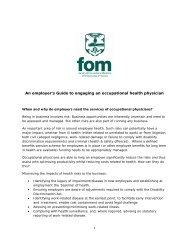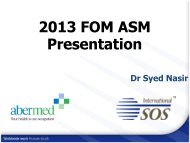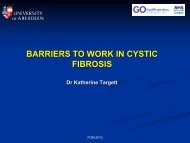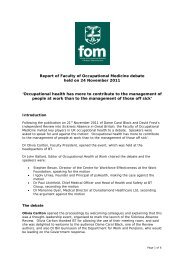Dr David Johnston - Faculty of Occupational Medicine
Dr David Johnston - Faculty of Occupational Medicine
Dr David Johnston - Faculty of Occupational Medicine
Create successful ePaper yourself
Turn your PDF publications into a flip-book with our unique Google optimized e-Paper software.
Carbon nanotubes: Should we worry?<br />
<strong>Dr</strong> <strong>David</strong> <strong>Johnston</strong><br />
MFOM Dissertation May 2012<br />
Consultant <strong>Occupational</strong> Health Physician, CAPITA
Carbon<br />
• Various allotropes <strong>of</strong> carbon exist<br />
• All have different arrangements <strong>of</strong> carbon atoms<br />
Amorphous (Coal)<br />
Graphite<br />
Diamond<br />
Fullerene<br />
CNT
Carbon nanotubes<br />
• Discovered in 1991<br />
• Can be pictured as a single layer <strong>of</strong> carbon atoms rolled to form a<br />
cylinder<br />
• Single(A) or Multiwalled(B)<br />
• Diameter <strong>of</strong> a single walled CNT 1-2nm<br />
• Length typically several micrometers
• 1 nanometer(nm) is one billionth <strong>of</strong> a meter.<br />
• A nanoparticle must have one dimension less than 100nm<br />
(10 2 nm)<br />
• Diameter CNT roughly between the size <strong>of</strong> a glucose molecule<br />
and virus depending on whether single or multiwalled<br />
• Width <strong>of</strong> human hair by comparison 10 000nm (10 4 nm)
Nanoparticles<br />
• We are surrounded by billions <strong>of</strong> nanoparticles<br />
– Natural nanoparticles<br />
– Incidental nanoparticles<br />
– Engineered nanoparticles<br />
• Approximately 20 000/cm 3 in a normal room<br />
• Unique properties that differ from their bulk counterparts
Why are CNTs <strong>of</strong> interest?<br />
• Stronger than steel<br />
• Conductive as copper<br />
• Thinner than hair<br />
• Conducting or semiconducting properties depending on structure<br />
• Can be combined with other material producing a high performance<br />
composite material<br />
• In 2010 the estimated global value <strong>of</strong> nanomaterials stood at $1.8 billion<br />
• By 2014 ten million manufacturing jobs worldwide will involve building<br />
products that incorporate nanotechnology
Applications for Carbon Nanotubes?
Applications for carbon nanotubes<br />
Industry<br />
Electronics and computing<br />
Aerospace industry<br />
Healthcare<br />
Environment<br />
Clothing, health and fitness<br />
Applications<br />
Nano sized electrical components<br />
Semiconductors<br />
Data storage<br />
Batteries<br />
Structural parts<br />
Controlled drug delivery<br />
Medical imaging<br />
Solar storage<br />
Waste recycling<br />
Reinforcement <strong>of</strong> material<br />
Sports equipment
Production <strong>of</strong> CNTs<br />
• Produced on a commercial scale using Chemical vapour deposition<br />
• Biggest production plants in Europe are in Germany and Belgium<br />
• These sites can produce 200 and 400 tonnes <strong>of</strong> CNT per year<br />
respectively<br />
• As scale <strong>of</strong> manufacturing and processing develops Increasing<br />
numbers <strong>of</strong> workers and those involved further down the lifecycle <strong>of</strong> the<br />
product will potentially be at risk <strong>of</strong> exposure to CNTs<br />
• Some safety concerns as questions have arisen regarding potential<br />
toxicity
Properties <strong>of</strong> concern<br />
1) Nanoscale size<br />
– Respirable particle, able to penetrate into distal airways <strong>of</strong> the lung<br />
– Incredibly large surface area.<br />
– Ability to move to other body systems<br />
2) Needle like shape<br />
3) Poor solubility / biological persistence<br />
4) Chemical composition<br />
– Metal catalysts used in manufacture may contribute to toxicity<br />
Carbon Nanotube<br />
Asbestos
Regulation in the UK<br />
• No additional legislation in the UK<br />
• Information sheet regarding CNTs published by HSE in March 2009<br />
– Highlighted employers responsibilities<br />
– Recommended a precautionary approach
Aim <strong>of</strong> the systematic review<br />
• To assess whether respiratory exposure to CNTs is associated with<br />
pulmonary toxicity.
Methods<br />
• Articles identified by searching online databases: medline, embase,<br />
pubmed, nioshtic-2 and oshline<br />
• Search involved using keywords for CNTs, route <strong>of</strong> exposure and<br />
system <strong>of</strong> interest<br />
• Included studies that assessed pulmonary toxicity following respiratory<br />
exposure to CNTS<br />
• Limited to studies published in English<br />
• Excluded review articles, in vitro studies
Methods<br />
Three outcomes evaluated<br />
1) Clinical outcomes<br />
Death, disturbed respiratory pattern<br />
2) Bronchoalveolar lavage outcomes (BAL)<br />
Markers <strong>of</strong> cytotoxocity or inflammation<br />
3) Histopathology outcomes<br />
Evidence <strong>of</strong> granulomas or fibrosis
Results<br />
Embase:<br />
345<br />
Medline:<br />
218<br />
Nioshtic- 2:<br />
126<br />
Pubmed:<br />
277<br />
Oshline:<br />
8<br />
Identified titles / abstracts<br />
+/- references reviewed<br />
974<br />
Potentially relevant. Full<br />
text obtained<br />
61<br />
Obvious exclusions<br />
913<br />
Exclusions applied<br />
42<br />
Unable to source<br />
1<br />
Additional articles from<br />
manual reference search<br />
1<br />
Full text articles fulfilling<br />
inclusion and exclusion criteria<br />
18<br />
Articles included in<br />
dissertation<br />
19
Characteristics <strong>of</strong> included articles<br />
• 19 studies identified were all in vivo experimental studies involving<br />
rodents<br />
• No human studies published<br />
• Study design involved comparison between groups<br />
• Animals exposed to CNTs and outcomes compared with positive and<br />
/or negative controls<br />
• Intratracheal, Oropharyngeal or Inhalational exposure<br />
• Inhalational studies exposure duration varied from 6 hours to 13 weeks.<br />
Other studies involved a single bolus exposure.<br />
• Animals sacrificed various time points from 6 hours to 273 days
Example <strong>of</strong> study methods<br />
Study Animal Type <strong>of</strong> CNT Route <strong>of</strong><br />
exposure<br />
Dose Exposure Animals sacrificed<br />
(days post<br />
treatment)<br />
Reddy et al.<br />
2010(8)<br />
Rats<br />
(Wistar)<br />
MWCNT<br />
diameter 60-80nm,<br />
Intratracheal 0.2, 1, 5 mg/kg Single dose 1, 7, 30, 90<br />
Mitchell et al.<br />
2007(48)<br />
Mice<br />
(C57BL/6)<br />
MWCNT<br />
diameter 10-20nm,<br />
length 5-15µm<br />
Inhalational 0.3, 1.0, 5.3 mg/m 3<br />
(estimate deposited<br />
dose<br />
0.2,0.5,2.7mg/kg)<br />
6 hours per day for 7<br />
or 13 consecutive days<br />
7, 14
Number <strong>of</strong> studies<br />
Number <strong>of</strong> studies documenting<br />
specific characteristics <strong>of</strong> CNT<br />
20<br />
18<br />
16<br />
14<br />
12<br />
10<br />
8<br />
6<br />
4<br />
2<br />
0<br />
Characteristics documented in study
Results - Clinical Outcomes<br />
Clinical outcomes<br />
Number <strong>of</strong> studies<br />
(n=19)<br />
Deaths reported 2<br />
Exposure significantly disturbed respiratory pattern 2<br />
Exposure had no significant effect on clinical observations +/-<br />
respiratory pattern<br />
6<br />
Study did not comment on clinical outcomes or only reported no<br />
deaths<br />
9
Results – Brochoalvelar Lavage (BAL)<br />
BAL outcomes<br />
Number <strong>of</strong> studies (n=19)<br />
Not assessed 5<br />
No significant difference 3<br />
Significant increase in GGT 3<br />
Significant increase in macrophages 4<br />
Significant increase in ALP 4<br />
Significant increase in collagen 4<br />
Significant increase in total cell count 6<br />
Significant increase in PMNs 6<br />
Significant increase in proteins 8<br />
Significant increase in LDH 10
Results - Histopathology<br />
Histopathology outcomes<br />
Number <strong>of</strong> studies<br />
(n=19)<br />
Not assessed 2<br />
No significant histopathological lesions 2<br />
Evidence <strong>of</strong> fibrosis 7<br />
Granulomas 11
Discussion<br />
• Findings from this systematic review suggest that CNTs are toxic to the<br />
lungs <strong>of</strong> rodents<br />
– Association with increased biomarkers <strong>of</strong> lung injury and<br />
inflammation on bronchoalveolar lavage<br />
– Histological evidence <strong>of</strong> granulomas and less frequently fibrosis<br />
• New technologies such as CNTs raise huge challenges for regulating<br />
authorities and occupational medicine<br />
• Until further information is known then a cautionary approach, reducing<br />
exposure using traditional hierarchy <strong>of</strong> controls measures prudent
What next?<br />
• Hazard characterisation and efforts to identify a dose response and no<br />
adverse effect level required.<br />
• Further studies to explore workplace exposure and effectiveness <strong>of</strong><br />
control measures<br />
• Consider other body systems<br />
• Consider other routes <strong>of</strong> exposure<br />
• Environmental impact.
Acknowledgements



